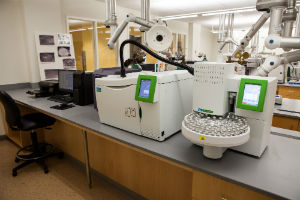The Blood Alcohol Program of the Vermont Forensic Laboratory routinely tests blood specimens, along with beverage alcohol samples for alcohol content using a headspace gas chromatograph. With this method a small amount of blood/beverage is added to an airtight vial and then heated to allow the volatile alcohol to evaporate into the top of the vial. The "headspace" or air at the top of the vial is then sampled by the instrument and run through the gas chromatograph where it is separated from other volatiles that might be in the sample and then quantitated.
Analysts in the Blood Alcohol Program routinely provide expert testimony in courts around the state on the topics of impaired driving, alcohol, its properties and the science of forensic alcohol testing.

Blood Alcohol FAQ
What is ethanol?
Ethyl alcohol is a clear, colorless, volatile liquid.
What is a blood alcohol concentration?
Grams of ethanol per 100 mL of whole blood.
What method of testing blood alcohol is used at the Vermont Forensic Laboratory?
Headspace Gas Chromatography.
What is the preferred blood collection tube to use when submitting evidence to the Vermont Forensic Laboratory?
Gray top tubes with anticoagulant and preservative, which can be found in blood collection kits.
Where do agencies get blood collection kits?
These kits are made available to all local and state agencies through the Vermont Forensic Laboratory.
What is the legal alcohol level in Vermont?
0.08 g/100mL of whole blood OR 0.08g/210L of breath

